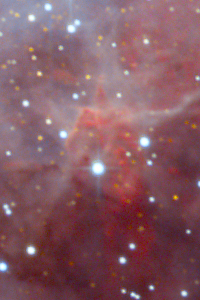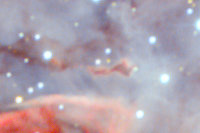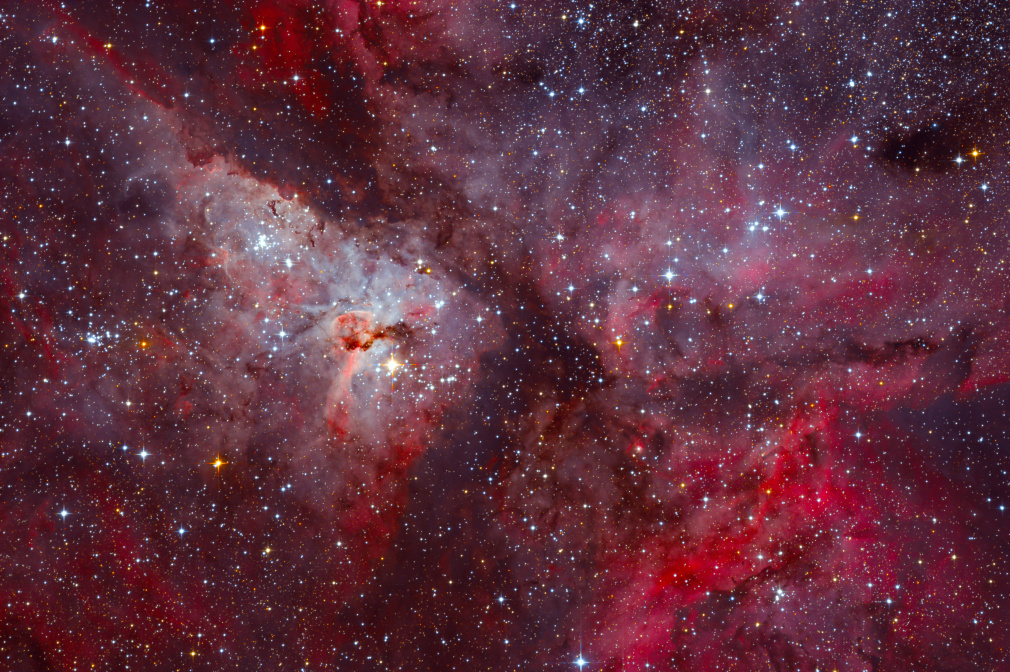One of the biggest of its kind in our night sky, the emission nebula which appears brighter and four times larger than Orion Nebula. Despite there are large number of globules, open clusters, dark and bright regions and even dust-pillars in it, its most interesting part is the star system which the nebula was named after, the famous Eta Carinae, the yellowish-reddish looking star in the picture.
The Eta Carinae Nebula
 The nebula which is located in the Carina-Sagittarius arm of Milky Way was discovered by Nicolas Louis de Lacille French astronomer in 1751 during his expedition to South Africa. The object visible by naked eye is known by several names amongst amateur astronomers: Eta Carinae Nebula, Carina Nebula or The Great Nebula in Carina. It is listed in several catalogues, its most known designations are NGC 3372 and Caldwell 92.
The nebula which is located in the Carina-Sagittarius arm of Milky Way was discovered by Nicolas Louis de Lacille French astronomer in 1751 during his expedition to South Africa. The object visible by naked eye is known by several names amongst amateur astronomers: Eta Carinae Nebula, Carina Nebula or The Great Nebula in Carina. It is listed in several catalogues, its most known designations are NGC 3372 and Caldwell 92.
The complex is located about 6-10000 light-years from us in the direction of the constellation of Carina. It's apparent size in the sky is about four times bigger than the Great Orion Nebula, and being also much farther, the difference between their actual sizes are even bigger. While the real size of Orion Nebula is about 12 light-years, the approximated extent of Eta Carinae Nebula is about 460 light-years.
Several open clusters can be discovered embedded in the nebula. All of them are parts of the giant OB association called the Carina OB1 association. Trumpler 14 is one of the youngest known open clusters in the sky, its age is only a few hundred thousand years. Trumpler 16, another cluster in the region, contains WR 25 a Wolf-Rayet star, which is the most luminous star we know in our galaxy. Although WR 25 is much brighter than Eta Carinae and they are at the same distance, WR 25 is located inside a dense cloud of dust which absorbs most of its light, so it looks dimmer than Eta Carinae.
 One of the most characteristic parts of the nebula is the dark patch right next to Eta Carinae, which was named the Keyhole by John Herschel. It is a formation consisting of dense gases and dust absorbing the light coming from objects behind it. The Homunculus Nebula, also known as The Little Man Nebula, is a bipolar nebula around star system Eta Carinae formed of gas ejected by the members of the system. It is not visible in the picture because Its apparent size is only 18" and it is washed out by the light of Eta Carinae. There was an extremely detailed picture taken of one of the pillars in the area by the new WFC3 camera of HST for the 20th anniversary of the space telescope. The picture was named the Mystic Mountain, because the area full of dense gas looked similar to a mountain.
One of the most characteristic parts of the nebula is the dark patch right next to Eta Carinae, which was named the Keyhole by John Herschel. It is a formation consisting of dense gases and dust absorbing the light coming from objects behind it. The Homunculus Nebula, also known as The Little Man Nebula, is a bipolar nebula around star system Eta Carinae formed of gas ejected by the members of the system. It is not visible in the picture because Its apparent size is only 18" and it is washed out by the light of Eta Carinae. There was an extremely detailed picture taken of one of the pillars in the area by the new WFC3 camera of HST for the 20th anniversary of the space telescope. The picture was named the Mystic Mountain, because the area full of dense gas looked similar to a mountain.
 Many EGGs (evaporating gas globules) can also be found in the picture. These look small, well defined dark spots in the picture. Stellar wind of the stars around them has compressed the gas they are formed of, while the strong UV radiation reaching their surface continuously evaporating them, hence the name evaporating gas globule, or EGG. In the picture it is clearly visible that their perimeter is brighter where the strong ionising radiation reaches them, making the gases to glow.
Many EGGs (evaporating gas globules) can also be found in the picture. These look small, well defined dark spots in the picture. Stellar wind of the stars around them has compressed the gas they are formed of, while the strong UV radiation reaching their surface continuously evaporating them, hence the name evaporating gas globule, or EGG. In the picture it is clearly visible that their perimeter is brighter where the strong ionising radiation reaches them, making the gases to glow.
The star Eta Carinae
Eta Carinae is a multiple star system about 7800 light-years from us, consisting of at least two stars. It is surrounded by dense interstellar medium, which makes its observation difficult. Even its binary structure could not been confirmed until 2005. The combined luminosity of the members of the system exceeds five million times the luminosity of our Sun.
Eta Carinae was known as a 4th magnitude star without any interesting feature until its first eruption between 1837 and 1843. In those years it became the second brightest star in the sky, that period is called the Period of Great Eruption. After that, in about a decade, its brightness decreased continuously much below its original brightness. In the 1940s it started to brighten again, reaching 4.5 magnitude in 2014.
The eruption in 1843 looked like a supernova-explosion, but the star did not collapse in the way regular supernovae used to. Its brightening in the past few decades showed that Eta Carinae's eruption was not a real supernova-explosion. Stars showing this kind of behaviour are called supernova impostors.
Because of its extraordinary performance, Eta Carinae got in the spotlight of many researches. It turned out that Eta Carinae is not a single star, but a stellar system in which at least two giant stars are orbiting each other.
The smaller star is blue giant star of spectral class O, aged about 3 million years. Its mass is about 30 solar masses. The bigger star is a luminous blue variable star, also about 3 million years old, and it is at least 100 times more massive than our Sun.
Because the expected life span of a star and the way they end is highly affected by their initial mass, Eta Carinae is very probably near to the end of its life. Stars heavier than 60 solar masses reach their end of life usually within less then 3 million years, when their core collapses and they become black holes. Giant stars with low metallicity can collapse into a black hole without a visible explosion, but massive stars with high metallicity may produce a spectacular supernova explosion. In astrophysics elements heavier than helium are simply considered metallic, and stars' metallicity means the amount of metallic elements they contain.
There are a lot of factors in case of Eta Carinae which make predictions about its destiny difficult if not impossible. Eta Carinae is the only one of its kind, we don't know any other system with similar characteristics neither in Milky Way, nor in any other galaxy. Also impacts of its companion star cause a lot of unpredictability. It is certain though, that the bigger star in Eta Carinae system is very close to the end of its life, which is also indicated by its former eruptions, it may collapse into a black hole at any moment. Probably it will produce a supernova explosion reaching -4 magnitude of brightness, which will be the brightest supernova we have ever known.
